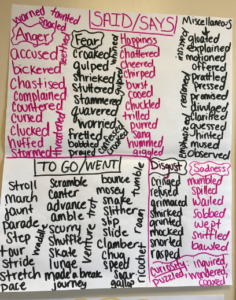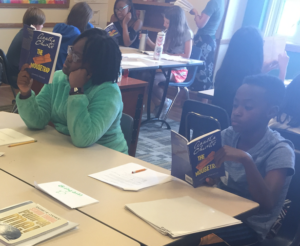Summer SAVY 2018: Session 4, Day 4 – Mysterious World in Writing (Rising 5th/6th)
Posted by morganr1 on Thursday, July 12, 2018 in Grade 5, Grade 6, SAVY.
I can’t believe the end of the week is just around the corner! I’ve had such a wonderful time working with your students, and I’m so proud of all we have accomplished and built together this week so far.
Today was primarily spent as a Revision + Writing Day, as students begin to wrap up their stories, and we near the end of the week.
In the morning, students listened to conductor Isidora Zebeljan’s
adaptation of Three Blind Mice for The Mousetrap soundtrack. Students were asked to write down three specific images or descriptive sensory details that this song evoked for them, as they were listening. What they came up with: bandit-mice tip-toeing, cats about to pounce, waiting behind a closed door, holding your breath, among others. Then, students were asked to discuss “nursery rhyme” structures with their classmates. What effect does a nursery rhyme such as “Three Blind Mice” have on establishing tone? How might tone and content contrast, or complement one another in nursery rhymes? What is the effect of repetition and rhyme? Students shared their ideas with their tables, and we then came together as a class to consider the ways you can create
music through language (action verbs!), and how seemingly innocent nursery rhymes might entail darker undertones through tone — as well as a structure/foreshadow of a plot.
Students had time to work on their mysteries in the morning. Students then were introduced to Revision. We discussed the differences between Editing (proofreading for punctuation, grammar) and Revising (reviewing your story and attempting to understand/chip away at the bigger picture: plot structure, character development, word choice, etc.) We discussed constructive criticism as a class: How might we offer our most respectful, insightful, honest and specific feedback to one another as peer readers?
Students were assigned into Peer Review groups of threes or fours. Their task was to read another peer’s mystery, and fill out a Peer Edit Worksheet that asked them to closely analyze each mystery for: strengths, plot summary (elements), exposition through resolution, perspective, literary elements learned this week (suspense, red herrings, tone/mood, suspenseful dialogue, imagery, meter, etc.), questions, distracting or confusing sentences. Students were very excited about this exercise, and are eager to share/read each other’s creations!!
After Peer Reviewing, students had a chance to reflect on their reader’s comments, think about applying revisions to their own story, and resume writing/working on their mysteries.
In the afternoon, we headed to the Computer Lab, rough drafts in hand! We began typing up excerpts from our mysteries for the Open House.
We headed back to the classroom and finished up a class reading of The Mousetrap. Today, the rising action all came to a swoop with a mind-boggling climax! I’m sure students would love to discuss who the final murderer of the play was with parents and siblings. We wrapped up our conversation about the Mousetrap by charting which specific literary techniques Christie employed in her play. Students were particularly interested in how red herrings took the form of characters, and we spent some more time discussing how to create suspicion/suspense through action and dialogue. (Trotter, a character in the play, for example, spends some time twirling his hair while interviewing Miss Casewell. Students pointed to this action as a clue that led us to suspect Trotter as the ultimate culprit!)
Next, we had a fun lesson on Juicy Verbs and Vibrant Adjective Students! discussed the process of Showing, not TELLING. We want to avoid using explanatory language or details in our mysteries that might disengage the reader, so to do this, we might consider revamping sentences such as “It was hot” to something like “Sun poured like boiling water down my back.” We reviewed concepts such as: Alliteration, characterization, author’s ‘voice,’ similies + metaphors, sensory detail, imagery.
Parents, some examples of exciting sentences we came up with as a class today:
– It was raining. —> “Rain drizzled down my back like little snakes slithering down a tall tree.” slithered like slippery snakes down my back.”
– The ground was wet. –> The swampy, mossy ground underneath my feet sucked my books in like quicksand.
Today, we also posted large “VERB + ADJECTIVE CHARTS” on the walls — transforming ordinary verbs such as laughed to a variety of verbs: snickered, giggled, roared, chuckled, hee-hawed. These verb and adjective charts will hopefully give students inspiring fuel as they continue to revise their mysteries tomorrow, and allow them to incorporate show/don’t tell into their writing practices in the future.
Students spent the latter part of class revising and writing their stories. Students who were already finished with their stories had another chance for a second Peer Review.
We are so excited to share their week’s efforts with you all tomorrow!
-Miss Carlina
PS: Dear Parents! Some of your students expressed interest in working on their stories more at home tonight! (This was not required, but writers who express interest are always encouraged!!) If your writer brought home their folder or mystery with them tonight, PLEASE make sure they bring their materials BACK to SAVY tomorrow morning. This is very important, as we will be working on our mysteries more in the morning, and spending time in the Computer Lab, as well.
Furthermore, if your writer decided to type more of their story at home tonight, it is recommended that they have a way of digitally accessing this file tomorrow (whether through email, DropBox, etc.) in order to print.
Some Highlights From Our Day




